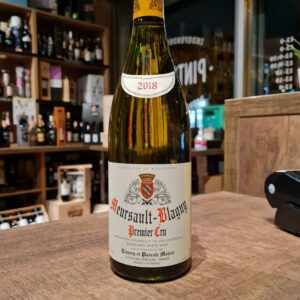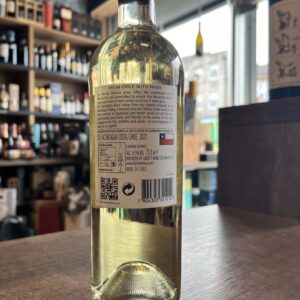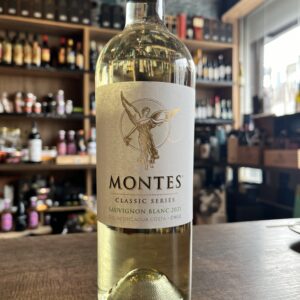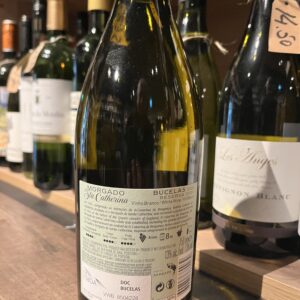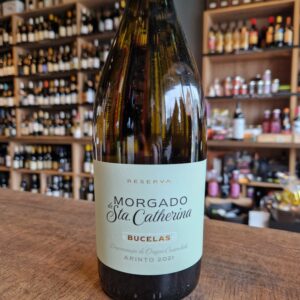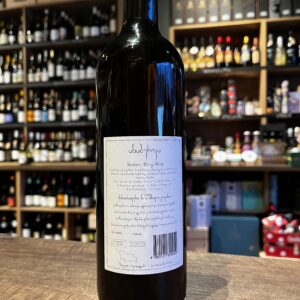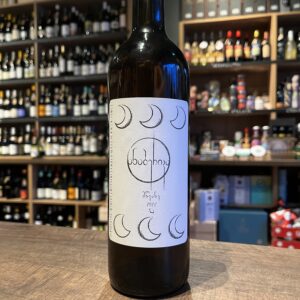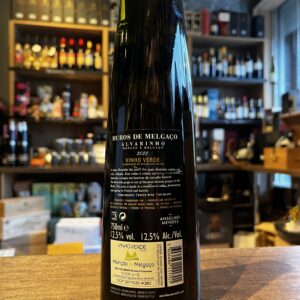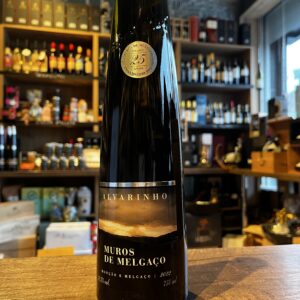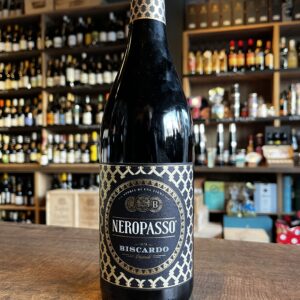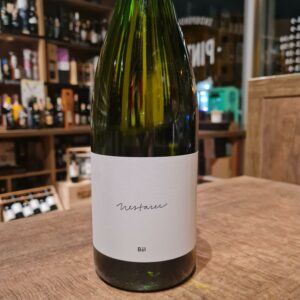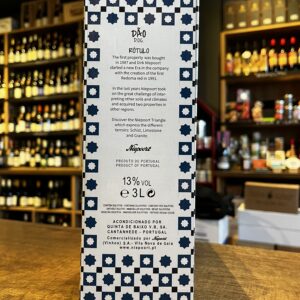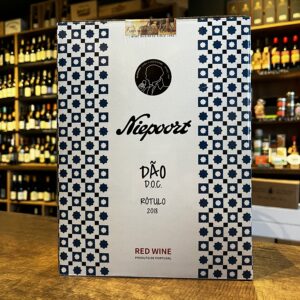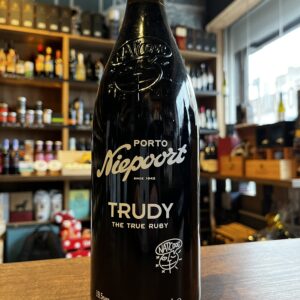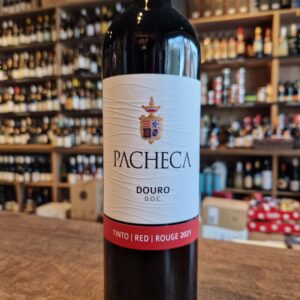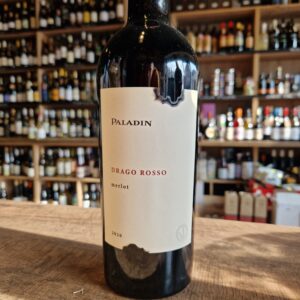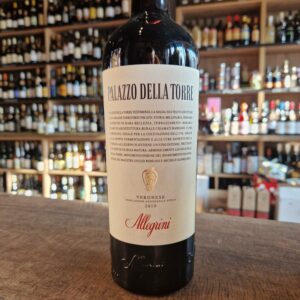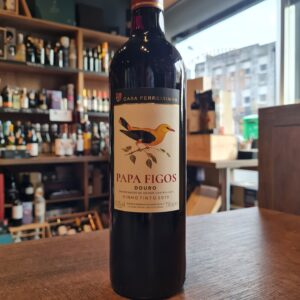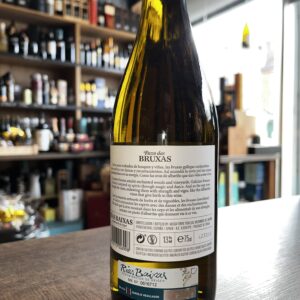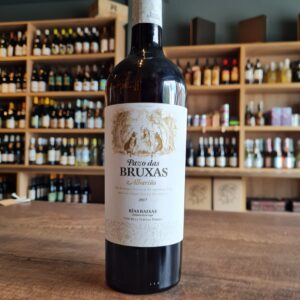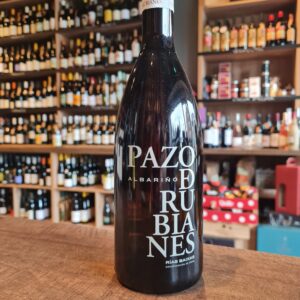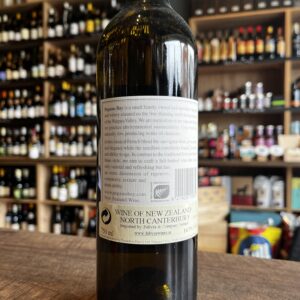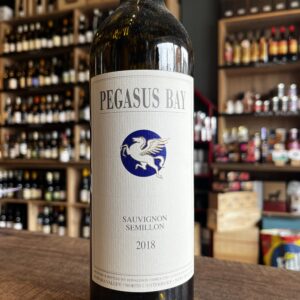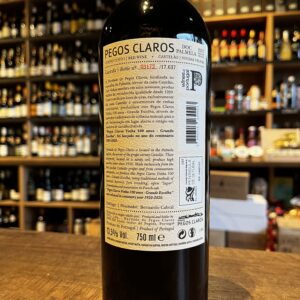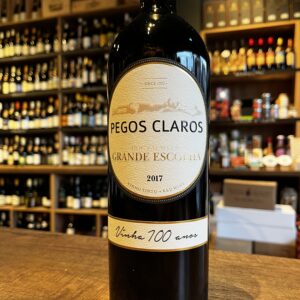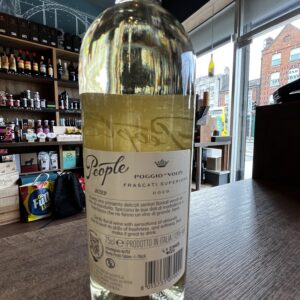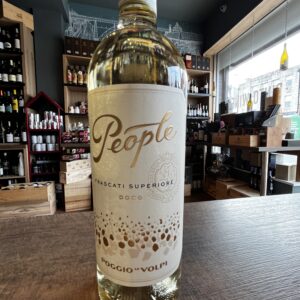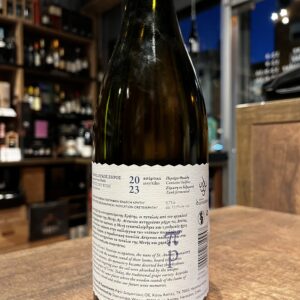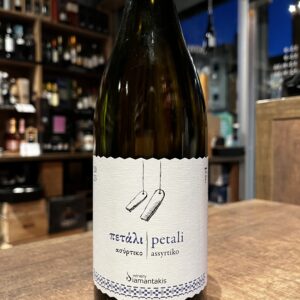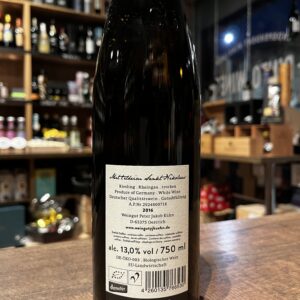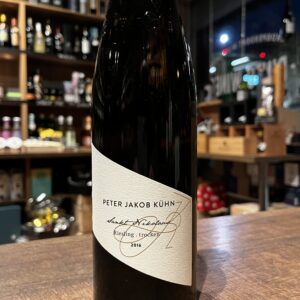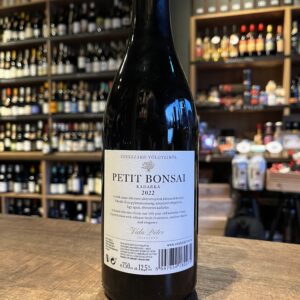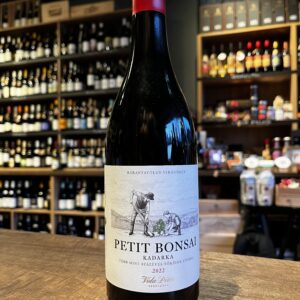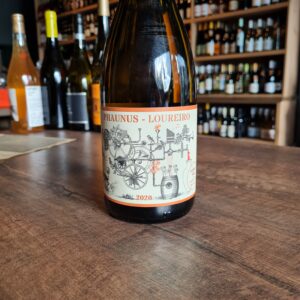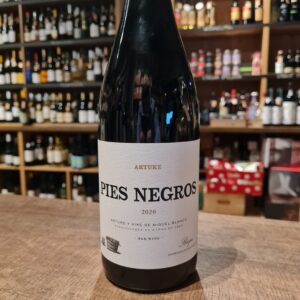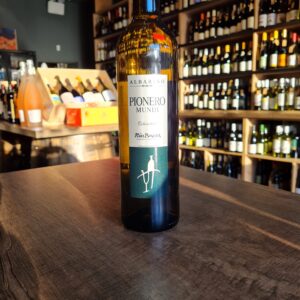-
 Menina d’Uva is a small winery located in Uva, a remote village in the quiet and desolate countryside of the Northeast of Portugal. Female winemaker Aline Domingues moved from Paris to this area from which her parents had emigrated to Paris to give their children better opportunities. A controversial move within the family but one that I wholeheartedly support. Aline clearly is a talented winemaker crafting beautifully pure wines. Made from 70% red grapes (including Bastardo, known in the Jura as Trousseau) and 30% white grapes including Malvasia and white Bastardo. It’s still a hearthy red that’s crispy and refreshing; cherries, pomegranate with a beautiful smell of the forest. Highly recommended.
Menina d’Uva is a small winery located in Uva, a remote village in the quiet and desolate countryside of the Northeast of Portugal. Female winemaker Aline Domingues moved from Paris to this area from which her parents had emigrated to Paris to give their children better opportunities. A controversial move within the family but one that I wholeheartedly support. Aline clearly is a talented winemaker crafting beautifully pure wines. Made from 70% red grapes (including Bastardo, known in the Jura as Trousseau) and 30% white grapes including Malvasia and white Bastardo. It’s still a hearthy red that’s crispy and refreshing; cherries, pomegranate with a beautiful smell of the forest. Highly recommended. -
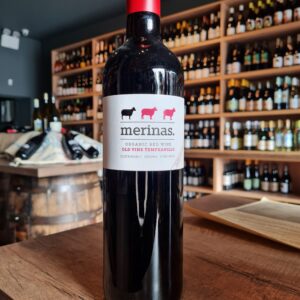 The Mesta was a powerful alliance of shepherds in medieval Castile, who controlled the “cañadas”: traditional rights-of-way for migrating sheep. to this day, the “cañadas” are protected from being blocked or built upon. Our vineyards are nestled deep in the land of The Mesta, and are still passed over by flocks on their annual migration – a reminder of ancient rights, and a cultural cue for continued co-existence with nature. Produced from organically farmed vineyards in Uclés (Castile, Spain). Managed as an integrated ecosystem and studded with centenary oak trees. The continental climate with sunny days and cool nights allow us to achieve intense fruit and excellent varietal definition, while retaining remarkable freshness Mesta Tempranillo is a vibrant and juicy, unoaked red wine, showing great purity and the typicity of high-altitude Tempranillo, with expressive and well-defined aromas of red berries, rosemary and a touch of liquorice. Bright ruby red colour. Fresh and with an excellent persistence on the palate, with round texture and a satisfyingly dry finish. Very versatile, medium-bodied food wine, excellent with tapas, grilled meat and pasta.
The Mesta was a powerful alliance of shepherds in medieval Castile, who controlled the “cañadas”: traditional rights-of-way for migrating sheep. to this day, the “cañadas” are protected from being blocked or built upon. Our vineyards are nestled deep in the land of The Mesta, and are still passed over by flocks on their annual migration – a reminder of ancient rights, and a cultural cue for continued co-existence with nature. Produced from organically farmed vineyards in Uclés (Castile, Spain). Managed as an integrated ecosystem and studded with centenary oak trees. The continental climate with sunny days and cool nights allow us to achieve intense fruit and excellent varietal definition, while retaining remarkable freshness Mesta Tempranillo is a vibrant and juicy, unoaked red wine, showing great purity and the typicity of high-altitude Tempranillo, with expressive and well-defined aromas of red berries, rosemary and a touch of liquorice. Bright ruby red colour. Fresh and with an excellent persistence on the palate, with round texture and a satisfyingly dry finish. Very versatile, medium-bodied food wine, excellent with tapas, grilled meat and pasta. -
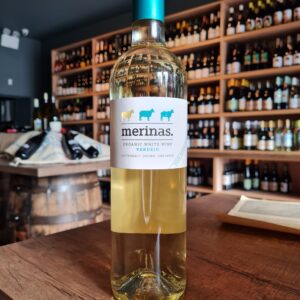 Merinas comes from the Bodegas y Viñedos Fontana, located in the town of Cuenca. The name Merinas is also a reference to the merino sheep, the most famous sheep breed in the world which, incidentally, sometimes seems to scurry around in the vines. A crisp, aromatic white wine, showing great purity of aromas and a precise expression of the Verdejo grape. Bright, pale straw yellow, with intense, fresh notes of grass, fennel and white pepper. Dry but juicy on the palate, with excellent balance, a moderate alcohol of only 12,5% with a persistent, slightly mineral finish. Excellent as an aperitif and with pasta, salads, poultry and fish dishes.
Merinas comes from the Bodegas y Viñedos Fontana, located in the town of Cuenca. The name Merinas is also a reference to the merino sheep, the most famous sheep breed in the world which, incidentally, sometimes seems to scurry around in the vines. A crisp, aromatic white wine, showing great purity of aromas and a precise expression of the Verdejo grape. Bright, pale straw yellow, with intense, fresh notes of grass, fennel and white pepper. Dry but juicy on the palate, with excellent balance, a moderate alcohol of only 12,5% with a persistent, slightly mineral finish. Excellent as an aperitif and with pasta, salads, poultry and fish dishes. -
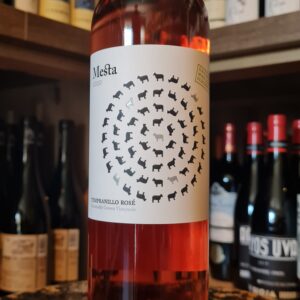 Mesta is a range of organically and sustainably grown single varietal wines, which stylishly showcase the Spanish wine revolution under the symbol of the Mesta. Mesta was a powerful alliance of sheep ranchers in medieval Castile, who controlled the cañadas: the traditional rights of way for migrating sheep. To this day the cañadas are protected from being blocked or built upon, a reminder of ancient rights and a model of coexistence with nature. This modern range, from the fashionable DO Uclés in central Castile, offers wines of great purity and varietal typicity.A versatile wine which accompanies spicy dishes perfectly, Asian curries, seafood risotto or a light salad with grilled prawns. Rosé wines are in fashion not just in the summer but also throughout the year, and this beautiful Mesta Rosé is a serious contender in the Rosé world. Especially at this price!!!
Mesta is a range of organically and sustainably grown single varietal wines, which stylishly showcase the Spanish wine revolution under the symbol of the Mesta. Mesta was a powerful alliance of sheep ranchers in medieval Castile, who controlled the cañadas: the traditional rights of way for migrating sheep. To this day the cañadas are protected from being blocked or built upon, a reminder of ancient rights and a model of coexistence with nature. This modern range, from the fashionable DO Uclés in central Castile, offers wines of great purity and varietal typicity.A versatile wine which accompanies spicy dishes perfectly, Asian curries, seafood risotto or a light salad with grilled prawns. Rosé wines are in fashion not just in the summer but also throughout the year, and this beautiful Mesta Rosé is a serious contender in the Rosé world. Especially at this price!!! -
Out of stock
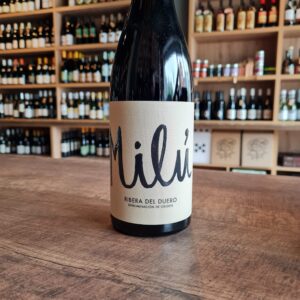 A rich and satisfying Ribera del Duero red, from a quality focussed micro producer Quinta Milú. This is a family run project in the Ribera del Duero from the Asturian viticulturist Germán R. Blanco. A small project which for nearly 10 years now has looked for wines which tell us about where they were born, a small village by the name of La Aguilera situated in the province of Burgos. Germán makes his elegant, fruit-forward wines using foot-treading, wild yeast fermentation and minimal handling. Not filtered, not clarified and not stabilized is his ethos. All his wines share a delicious rusticity, purity of fruit, and incredible freshness. Germán calls this— his flagship wine— a “vino de pueblo”, which translates as “a wine for every day and for everyone.” Pair it with braised meats, steak, game, lamb, root veggies, hard cheese or just have it on its own.
A rich and satisfying Ribera del Duero red, from a quality focussed micro producer Quinta Milú. This is a family run project in the Ribera del Duero from the Asturian viticulturist Germán R. Blanco. A small project which for nearly 10 years now has looked for wines which tell us about where they were born, a small village by the name of La Aguilera situated in the province of Burgos. Germán makes his elegant, fruit-forward wines using foot-treading, wild yeast fermentation and minimal handling. Not filtered, not clarified and not stabilized is his ethos. All his wines share a delicious rusticity, purity of fruit, and incredible freshness. Germán calls this— his flagship wine— a “vino de pueblo”, which translates as “a wine for every day and for everyone.” Pair it with braised meats, steak, game, lamb, root veggies, hard cheese or just have it on its own. -
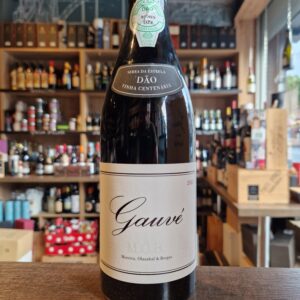 This project was born from the will of three winemakers, Jorge Moreira, Francisco Olazabal and Jorge Serôdio Borges, to make a wine together. The chosen region was the Dão, a region for which there is a common admiration that was born in the tasting of older wines, from the 60s and 70s that surprise for their elegance and freshness. The identity and complexity of these wines is indeed remarkable and serves as an inspiration for MOB wines.
This project was born from the will of three winemakers, Jorge Moreira, Francisco Olazabal and Jorge Serôdio Borges, to make a wine together. The chosen region was the Dão, a region for which there is a common admiration that was born in the tasting of older wines, from the 60s and 70s that surprise for their elegance and freshness. The identity and complexity of these wines is indeed remarkable and serves as an inspiration for MOB wines. -
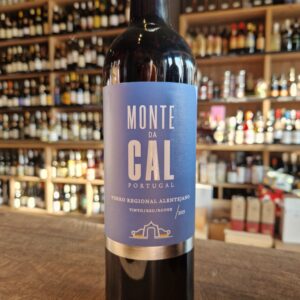 It is in the heart of the genuine Alentejo, with its unique aromas, flavors and textures, nature, silence and immensity, that the 80 hectares of vineyards at Herdade Monte da Cal, located in the municipality of Fronteira, in the parish of São Saturnino, extend over 80 hectares of vineyards. about 40 km from Portalegre. Surrounded by the tranquility of the northern Alentejo plain, it is part of the calm environment of nature characteristic of this part of the country, surrounded by an infinity of vineyards, which we can only see, far away. Here, the red varieties Trincadeira, Syrah, Aragonês, Alicante Bouschet, Alfrocheiro and Touriga Nacional are planted. The architecture and decoration of the estate reflect the Arab influences, so present in the Alentejo culture. The estate’s modern winery is a fundamental pillar to reinforce the visibility of the wines of this house, and a wine tourism project is already planned for this property. Suggested pairing with dishes from the Mediterranean, Chinese, Indian and African cuisine.
It is in the heart of the genuine Alentejo, with its unique aromas, flavors and textures, nature, silence and immensity, that the 80 hectares of vineyards at Herdade Monte da Cal, located in the municipality of Fronteira, in the parish of São Saturnino, extend over 80 hectares of vineyards. about 40 km from Portalegre. Surrounded by the tranquility of the northern Alentejo plain, it is part of the calm environment of nature characteristic of this part of the country, surrounded by an infinity of vineyards, which we can only see, far away. Here, the red varieties Trincadeira, Syrah, Aragonês, Alicante Bouschet, Alfrocheiro and Touriga Nacional are planted. The architecture and decoration of the estate reflect the Arab influences, so present in the Alentejo culture. The estate’s modern winery is a fundamental pillar to reinforce the visibility of the wines of this house, and a wine tourism project is already planned for this property. Suggested pairing with dishes from the Mediterranean, Chinese, Indian and African cuisine. -
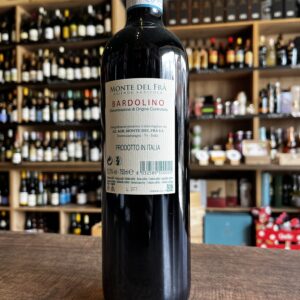
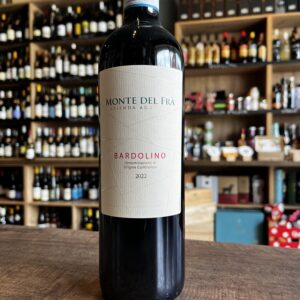 This wine is from the hills that are located in a Guyot at 100/150 meters above sea level, of morainic origin with calcareous, clayey, gravelly, sandy soil.From the municipality of Sommacampagna located southeast of Lake Garda.A well-balanced, fresh and easy-drinking style dry and rounded red wine. Delicately fruity and fragrant, with notes of cherries, strawberries, raspberries and red currants as well as hints of spices. Recommended with light snacks, cold cuts, light meals, tapas, pasta and fish in general (particularly freshwater fish).
This wine is from the hills that are located in a Guyot at 100/150 meters above sea level, of morainic origin with calcareous, clayey, gravelly, sandy soil.From the municipality of Sommacampagna located southeast of Lake Garda.A well-balanced, fresh and easy-drinking style dry and rounded red wine. Delicately fruity and fragrant, with notes of cherries, strawberries, raspberries and red currants as well as hints of spices. Recommended with light snacks, cold cuts, light meals, tapas, pasta and fish in general (particularly freshwater fish). -
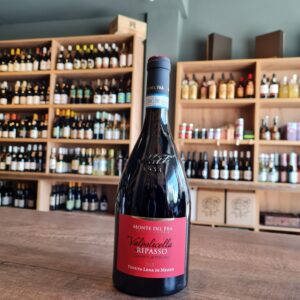 The Monte del Fra Valpolicella Classico appears deep ruby red with ripe red fruit accompanied with spice and earthiness on the nose. The palate displays delicious cherry and plum fruit, locked with sweet liquorice and warm cinnamon, finishing full, with velvety soft tannins and spice. Excellent wine that will get better and better, allow to breathe, even decant and would be best served with roasts, stews, braised meats and strong cheese.
The Monte del Fra Valpolicella Classico appears deep ruby red with ripe red fruit accompanied with spice and earthiness on the nose. The palate displays delicious cherry and plum fruit, locked with sweet liquorice and warm cinnamon, finishing full, with velvety soft tannins and spice. Excellent wine that will get better and better, allow to breathe, even decant and would be best served with roasts, stews, braised meats and strong cheese. -
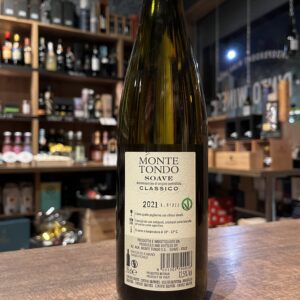
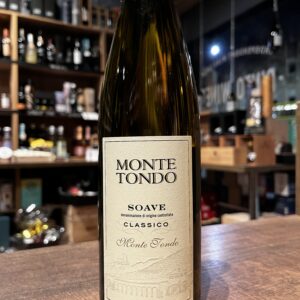
Monte Tondo is a family estate located in the beautiful hillside vineyards of Soave. Here the soils range from volcanic to chalky, which alongside the varying microclimates, gives the wines distinct flavour characteristics and individualistic style.
Alongside his family, winemaker Gino Magnabosco is part of the third generation to run the estate. They believe that hard work, drive, and determination are key to obtaining the best results from their land. Maintaining, nourishing, and cherishing the land of their ancestors is of utmost importance. And although not certified, they farm using organic practices and an environmentally friendly approach to both viticulture and vinification. No chemicals are used in their production and they recycle everything excess coming from the vineyard (stems as fertilizers, skins for grappa, pruned branches for heating and fertilizer).
Small proportions of other varieties are allowed in the production of Soave, but Monte Tondo focus their concentration purely on Garganega. Garganega is a variety so versatile and easily culinary matched but also with the ability to produce complex wines with age-ability.
A very good example of Soave at a very good price. This over-delivers.. Perfect with salads and light fish and shellfish dishes.
-
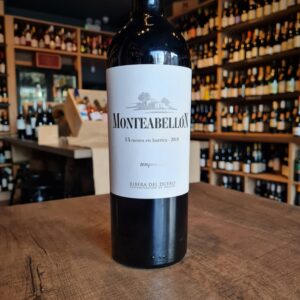 This Monteabellón 14 months is a wine made 100% with Tempranillo grapes from the highest altitude vineyards, located on sandy loam soils with clay and limestone. After a classic vinification, with 25 days of maceration, it is aged for 14 months in barrels of 70% French oak and 30% American . At Bodegas Monteabellón they use the latest oenological techniques to guarantee careful preparation throughout the process, maintaining stable levels of temperature and humidity. Smells of dark, ripe and very rich fruits. Unbelievably full-bodied and the finish is lasting and very long. This 100% Tempranillo is a complex wine that is already very enjoyable to drink, but will continue to develop splendidly over the next few years. Elegant and chocolate all over this wine. A shout to Declan & Mairead as they recommended this lovely addition to Pinto Wines!
This Monteabellón 14 months is a wine made 100% with Tempranillo grapes from the highest altitude vineyards, located on sandy loam soils with clay and limestone. After a classic vinification, with 25 days of maceration, it is aged for 14 months in barrels of 70% French oak and 30% American . At Bodegas Monteabellón they use the latest oenological techniques to guarantee careful preparation throughout the process, maintaining stable levels of temperature and humidity. Smells of dark, ripe and very rich fruits. Unbelievably full-bodied and the finish is lasting and very long. This 100% Tempranillo is a complex wine that is already very enjoyable to drink, but will continue to develop splendidly over the next few years. Elegant and chocolate all over this wine. A shout to Declan & Mairead as they recommended this lovely addition to Pinto Wines! -
Out of stock
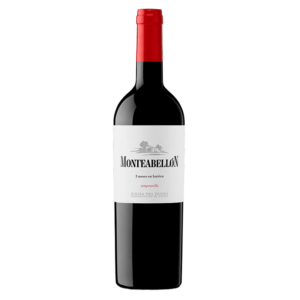 This attractive wine has its origin in the coolest vineyards located near the Douro River. The soil is sandy-loam with a slight gravel content. This gives it a very characteristic freshness that, combined with its aging in the barrel for 5 months (50% French and 50% American), gives rise to a wine with great personality and marked fruity nuances. Intense, bright cherry color. Very intense aroma with marked fruity sensations of blackberry and blueberries perfectly integrated with a quality wood that surrounds everything. Good structure and good fruity expression on the palate, powerful and with ripe tannins. An Oak from Ribera del Duero that you cannot miss.
This attractive wine has its origin in the coolest vineyards located near the Douro River. The soil is sandy-loam with a slight gravel content. This gives it a very characteristic freshness that, combined with its aging in the barrel for 5 months (50% French and 50% American), gives rise to a wine with great personality and marked fruity nuances. Intense, bright cherry color. Very intense aroma with marked fruity sensations of blackberry and blueberries perfectly integrated with a quality wood that surrounds everything. Good structure and good fruity expression on the palate, powerful and with ripe tannins. An Oak from Ribera del Duero that you cannot miss. -
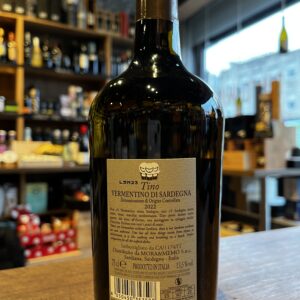
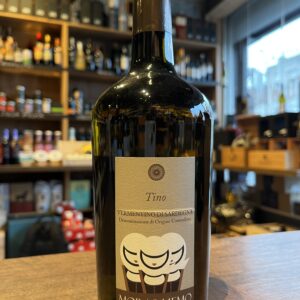 Their Vineyard is located in the south eastern corner of Sardinia in a rolling hill area looking at the sea of the Gulf of Cagliari. Vines with an average age of forty years our vineyards are able to express the best from the terroir of the south Sardinia. A unique terroir with the Sette Fratelli mountains, the tallest ones of the south of the island, just a mile away from the winery, behind them the beatiful beaches overlooking the Thyreenian sea. Pair with seafood in general, fish and delicate meat served with light sauces, soups or pasta.
Their Vineyard is located in the south eastern corner of Sardinia in a rolling hill area looking at the sea of the Gulf of Cagliari. Vines with an average age of forty years our vineyards are able to express the best from the terroir of the south Sardinia. A unique terroir with the Sette Fratelli mountains, the tallest ones of the south of the island, just a mile away from the winery, behind them the beatiful beaches overlooking the Thyreenian sea. Pair with seafood in general, fish and delicate meat served with light sauces, soups or pasta. -
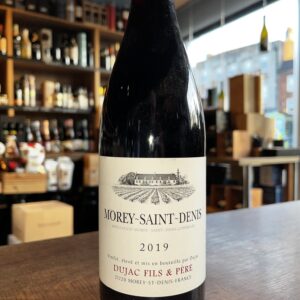 Founded in 1967 by Jacques Seysses, who transforms a newly acquired property into the Dujac domaine, it is now run together with his sons Jeremy, winemaker, and Alec. The property has 17.30 hectares of which a small part cultivated with chardonnay for an average production of less than 80,000 bottles. Jacques and his son Jeremy (whose wife Diana winemaker works in the domaine) are faithful to a very marked pinot noir through the vinification of whole grapes: the wine obtained rarely has a great color, but after a long aging (even beyond the thirty ' years) tertiary aromas do justice to this winemaking. Dujac style is the search for elegance and finesse with integrated and soft tannins always with balance, harmony, length and complexity. At the base the work in the vineyard, serious and rigorous, where the experience and knowledge of technology can help in the small imperfections of the vintage, but without any tampering. The brothers Alec and Jeremy, continuing in their father's work, are today considered among the best interpreters of the Pinot Noir of the Côte de Nuits and the Domaine Dujac can be fully confirmed as one of the most important Burgundy producers. In 2019 Morey has had another very successful vintage, receiving more rainfall in August than anywhere else on the Côte. The limestone subsoil also seems to give the wines a little more bite. The fruit is perfumed, with the classic Morey blueberry touches. The wine has good concentration and an energetic finish.
Founded in 1967 by Jacques Seysses, who transforms a newly acquired property into the Dujac domaine, it is now run together with his sons Jeremy, winemaker, and Alec. The property has 17.30 hectares of which a small part cultivated with chardonnay for an average production of less than 80,000 bottles. Jacques and his son Jeremy (whose wife Diana winemaker works in the domaine) are faithful to a very marked pinot noir through the vinification of whole grapes: the wine obtained rarely has a great color, but after a long aging (even beyond the thirty ' years) tertiary aromas do justice to this winemaking. Dujac style is the search for elegance and finesse with integrated and soft tannins always with balance, harmony, length and complexity. At the base the work in the vineyard, serious and rigorous, where the experience and knowledge of technology can help in the small imperfections of the vintage, but without any tampering. The brothers Alec and Jeremy, continuing in their father's work, are today considered among the best interpreters of the Pinot Noir of the Côte de Nuits and the Domaine Dujac can be fully confirmed as one of the most important Burgundy producers. In 2019 Morey has had another very successful vintage, receiving more rainfall in August than anywhere else on the Côte. The limestone subsoil also seems to give the wines a little more bite. The fruit is perfumed, with the classic Morey blueberry touches. The wine has good concentration and an energetic finish. -
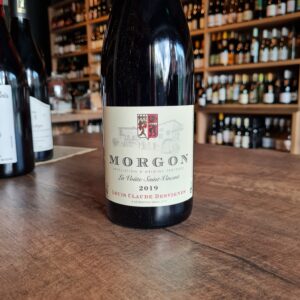 Louis-Claude Desvignes is a family estate that dates back to 1700. The Desvignes range is "La Voûte Saint Vincent", named for the vault or "voûte" of the old family house and for the patron saint of winemakers. It was Louis-Claude who began to turn the estate’s grapes into wine, and now with the reins handed over to his two sons Louis-Benoît and Claude-Emmanuelle Desvignes. It is a blend of certified-organic estate parcels totalling 4.5 hectares in the climat of Douby, which lies in the northeast corner of Morgon along the border of Fleurie. The La Voûte vines average 50 years old and are planted in Douby's typical sandy, decomposed-granite soils. Viticulture and vinification are consistent across all Desvignes wines. In the case of La Voûte, the parcels are all vinified separately.
Louis-Claude Desvignes is a family estate that dates back to 1700. The Desvignes range is "La Voûte Saint Vincent", named for the vault or "voûte" of the old family house and for the patron saint of winemakers. It was Louis-Claude who began to turn the estate’s grapes into wine, and now with the reins handed over to his two sons Louis-Benoît and Claude-Emmanuelle Desvignes. It is a blend of certified-organic estate parcels totalling 4.5 hectares in the climat of Douby, which lies in the northeast corner of Morgon along the border of Fleurie. The La Voûte vines average 50 years old and are planted in Douby's typical sandy, decomposed-granite soils. Viticulture and vinification are consistent across all Desvignes wines. In the case of La Voûte, the parcels are all vinified separately. -
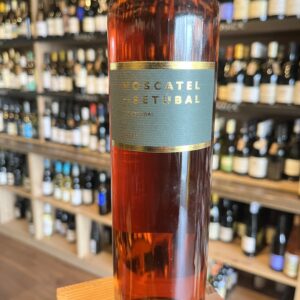
Casa Ermelinda Freitas
The warmth of the Portuguese sun is tempered at Casa Ermelinda thanks to the breezes blowing in from the Atlantic that lies close by. Located at Palmela on the peninsula of Setubal, close to the Sado estuary south of Lisbon, there are currently 440 hectares of many different kinds of vines across the domain, with grapes supplied locally from a further 500ha or so. Head of the company Leonor Freitas has worked tirelessly to make many improvements out in the vineyards and in the winery where modern equipment goes hand in hand with traditional values under the skilled guidance of winemaker Jaime Quendera. Casa Ermelinda Freitas has been run by a long line of dynamic women, celebrating its 100 year anniversary in 2020.
-
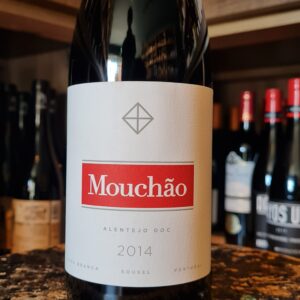 Herdade do Mouchao is a historic winery in Portugal’s Alentejo region that specialises in producing excellent red wines from the local Alicante Bouschet grape. The estate’s roots date back to the 19th century when Thomas Reynolds first moved from Porto to Alentejo to enter the prosperous cork-making industry. Later his grandson, John Reynolds saw an opportunity to start making both wine and corks and purchased the 900 hectare Herdade do Mouchao estate. Vineyards were planted, in 1901 he built a high-ceilinged adobe winery (or “adega”) and a distillery was added to the winery in 1929, where until today Mouchão's pommace brandy is produced. Unfortunately the estate was seized in 1974 by order of the powerful military government ruling the country at the time. The Reynolds were only able to regain the estate in 1985 and today the family works around 38 hectares of vines. Today, the Herdade do Mouchão continues to be run by the descendants of the original family whose cellar and vineyard workers have been with them for generations. The process is, as it always has been, unhurried (There is alway Manana). The grape varieties are local, picked by hand and foot-trodden. In the ever-changing world of winemaking, Herdade do Mouchão, remains a traditional, family-run winery.
Herdade do Mouchao is a historic winery in Portugal’s Alentejo region that specialises in producing excellent red wines from the local Alicante Bouschet grape. The estate’s roots date back to the 19th century when Thomas Reynolds first moved from Porto to Alentejo to enter the prosperous cork-making industry. Later his grandson, John Reynolds saw an opportunity to start making both wine and corks and purchased the 900 hectare Herdade do Mouchao estate. Vineyards were planted, in 1901 he built a high-ceilinged adobe winery (or “adega”) and a distillery was added to the winery in 1929, where until today Mouchão's pommace brandy is produced. Unfortunately the estate was seized in 1974 by order of the powerful military government ruling the country at the time. The Reynolds were only able to regain the estate in 1985 and today the family works around 38 hectares of vines. Today, the Herdade do Mouchão continues to be run by the descendants of the original family whose cellar and vineyard workers have been with them for generations. The process is, as it always has been, unhurried (There is alway Manana). The grape varieties are local, picked by hand and foot-trodden. In the ever-changing world of winemaking, Herdade do Mouchão, remains a traditional, family-run winery. -
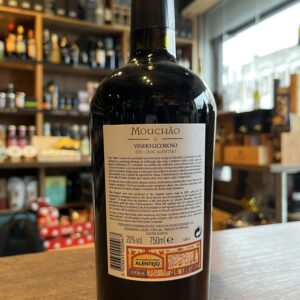
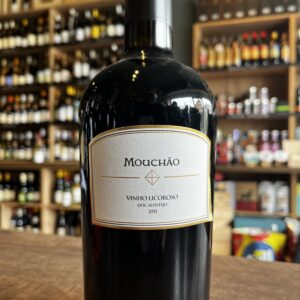 This fortified wine has been produced in Mouchão since the winery was built in 1901. The best grapes from Alicante Bouschet were harvested by hand and trodden by foot in traditional stone presses. The grapes are gently macerated until the fermentation process begins in order to develop a round, subtle and soft mouthfeel. After 120 years, this fortified dessert wine continues to be essential in the homes of Alentejo families at Christmas time. Sold and consumed young, mainly at the beginning of December of the same year of production. Nowadays its popularity is growing outside the festive season and is served in restaurants, very cold after meals. A very traditional and forming part of the tradition of the Northeast Alentejo.
This fortified wine has been produced in Mouchão since the winery was built in 1901. The best grapes from Alicante Bouschet were harvested by hand and trodden by foot in traditional stone presses. The grapes are gently macerated until the fermentation process begins in order to develop a round, subtle and soft mouthfeel. After 120 years, this fortified dessert wine continues to be essential in the homes of Alentejo families at Christmas time. Sold and consumed young, mainly at the beginning of December of the same year of production. Nowadays its popularity is growing outside the festive season and is served in restaurants, very cold after meals. A very traditional and forming part of the tradition of the Northeast Alentejo. -
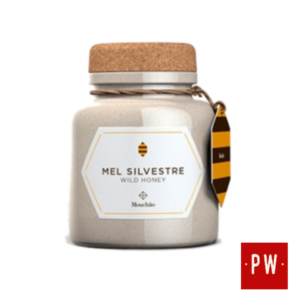 Although beehives have existed in Mouchão for over a century, honey was first commercially sold in 2011. In the expansive and natural surroundings of the estate, bees craft this wild honey with pollen from native shrubs, trees, and wild meadows. Beekeeping intervention is limited almost exclusively to harvesting. The honey, due to its purity, tends to thicken over time and can vary both in consistency and in its darker golden hue. Usually with a thick but smooth texture, it has floral highlights of orange blossom, wild lavender, and jasmine, with undertones of biscuit, butter, and dried fruits. As this is a raw honey, over the months it tends to thicken and can vary both in consistency and in darker golden hues.
Although beehives have existed in Mouchão for over a century, honey was first commercially sold in 2011. In the expansive and natural surroundings of the estate, bees craft this wild honey with pollen from native shrubs, trees, and wild meadows. Beekeeping intervention is limited almost exclusively to harvesting. The honey, due to its purity, tends to thicken over time and can vary both in consistency and in its darker golden hue. Usually with a thick but smooth texture, it has floral highlights of orange blossom, wild lavender, and jasmine, with undertones of biscuit, butter, and dried fruits. As this is a raw honey, over the months it tends to thicken and can vary both in consistency and in darker golden hues. -
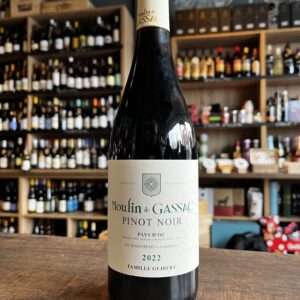 One of the wine films that has had the greatest impact on the industry is undoubtedly Jonathan Nossiter's “Mondovino”. This film was presented at the Cannes Film Festival in 2004, and essentially reflects the conflict between those who understand wine production as a basic artisan work that is completely connected to the land, and those who see it as a corporate business. One of the interviewees featured in the documentary is Aimé Guibert. Creator and champion of the renowned Mas Daumas Gassac, it is thanks to his obsession of giving absolute prominence to the vineyard that he manages to extol the quality of the wines of Languedoc, a region historically known for producing low quality table wines. So when Robert Mondavi, a wine magnate, became interested in this still under used region, Aimé fought with all his might until Mondavi withdrew from his venture. Now, it is his children who continue to protect this legacy with the same passion. A legacy based not so much on the category of the wine as on its quality. Although these wines only carry the vin de pays de l'Oc label, they are considered by great wine specialists to be the “Lafite Rothschilds” of Languedoc-Roussillon.
One of the wine films that has had the greatest impact on the industry is undoubtedly Jonathan Nossiter's “Mondovino”. This film was presented at the Cannes Film Festival in 2004, and essentially reflects the conflict between those who understand wine production as a basic artisan work that is completely connected to the land, and those who see it as a corporate business. One of the interviewees featured in the documentary is Aimé Guibert. Creator and champion of the renowned Mas Daumas Gassac, it is thanks to his obsession of giving absolute prominence to the vineyard that he manages to extol the quality of the wines of Languedoc, a region historically known for producing low quality table wines. So when Robert Mondavi, a wine magnate, became interested in this still under used region, Aimé fought with all his might until Mondavi withdrew from his venture. Now, it is his children who continue to protect this legacy with the same passion. A legacy based not so much on the category of the wine as on its quality. Although these wines only carry the vin de pays de l'Oc label, they are considered by great wine specialists to be the “Lafite Rothschilds” of Languedoc-Roussillon. -
Out of stock
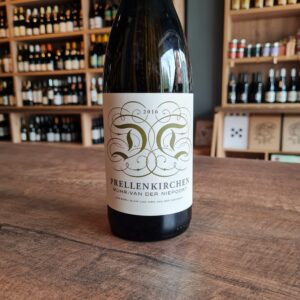 The exciting Muhr-Van der Niepoort project began in 2002 as a collaboration between Austrian PR guru Dorli Muhr and celebrated Portuguese winemaker Dirk Niepoort. Although the name is taken from the village of Prellenkirschen, all of the grapes for the white are sourced from the Spitzerberg, or a continuation of it. A blend of 90% Gruner Veltliner (35 year old vines) and 10% Riesling (planted in 1950), the grapes see some skin contact in the fermentation, imbuing the final wine with tension and extract, a mouth-watering savoury salinity and clearly-delineated spicy flavours of white pepper, fennel and cumin. Deep and a touch wild on the palate but with enormous personality and interest, its deep savoury style will appeal to lovers of edgy yet serious food-friendly whites.
The exciting Muhr-Van der Niepoort project began in 2002 as a collaboration between Austrian PR guru Dorli Muhr and celebrated Portuguese winemaker Dirk Niepoort. Although the name is taken from the village of Prellenkirschen, all of the grapes for the white are sourced from the Spitzerberg, or a continuation of it. A blend of 90% Gruner Veltliner (35 year old vines) and 10% Riesling (planted in 1950), the grapes see some skin contact in the fermentation, imbuing the final wine with tension and extract, a mouth-watering savoury salinity and clearly-delineated spicy flavours of white pepper, fennel and cumin. Deep and a touch wild on the palate but with enormous personality and interest, its deep savoury style will appeal to lovers of edgy yet serious food-friendly whites. -
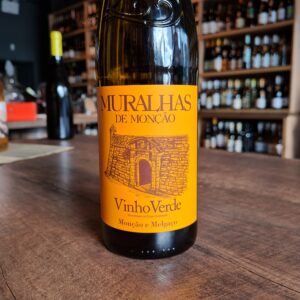 Monção e Melgaço has been producing wines and recognized for it since Roman occupation times, but was with Afonso III, 5th King of Portugal(1210-1279) that signed a ''Foral'' that conceded Monção e Melgaço habitants the owners of the local wine and therefore they produced it with pride as they do today. The wine is made from the Alvarinho (predominant) and Trajadura varieties, indigenous to Portugal and the region, more specifically. The dry Muralhas de Moncao Vinho Verde never seems intrusive, but is soft, elegant and harmonious with no wood whatsoever. The wine goes well not only as an aperitif, but also with salads, seafood, fish dishes and white meat.
Monção e Melgaço has been producing wines and recognized for it since Roman occupation times, but was with Afonso III, 5th King of Portugal(1210-1279) that signed a ''Foral'' that conceded Monção e Melgaço habitants the owners of the local wine and therefore they produced it with pride as they do today. The wine is made from the Alvarinho (predominant) and Trajadura varieties, indigenous to Portugal and the region, more specifically. The dry Muralhas de Moncao Vinho Verde never seems intrusive, but is soft, elegant and harmonious with no wood whatsoever. The wine goes well not only as an aperitif, but also with salads, seafood, fish dishes and white meat. -
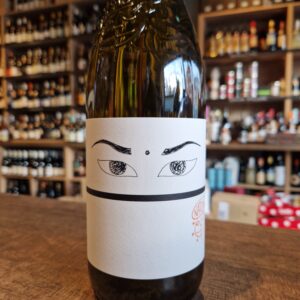 Nat Cool is naturally “cool and funky”. It represents an innovative concept initiated by Niepoort, in which various producers came together to create light, easy-to-drink wines. In the Vinho Verde region, we produced a wine typical of the region – a wine which references the “cloudy” wines of the past which were bottled with some residual sugar and fine lees, and therefore re-fermented in the bottle. Welcome to the Nat Cool world! This white wine was produced using a minimal intervention winemaking approach and is naturally turbid as it fermented in the bottle. It is intentionally not clarified and its aromas are reminiscent of the wines that used to be produced in the Vinho Verde region long ago. This is an intentionally uncomplicated wine: lightly shake the bottle before opening and enjoy with traditional Portuguese snacks!
Nat Cool is naturally “cool and funky”. It represents an innovative concept initiated by Niepoort, in which various producers came together to create light, easy-to-drink wines. In the Vinho Verde region, we produced a wine typical of the region – a wine which references the “cloudy” wines of the past which were bottled with some residual sugar and fine lees, and therefore re-fermented in the bottle. Welcome to the Nat Cool world! This white wine was produced using a minimal intervention winemaking approach and is naturally turbid as it fermented in the bottle. It is intentionally not clarified and its aromas are reminiscent of the wines that used to be produced in the Vinho Verde region long ago. This is an intentionally uncomplicated wine: lightly shake the bottle before opening and enjoy with traditional Portuguese snacks! -
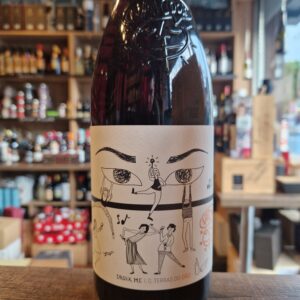 Nat Cool is an innovative, naturally “cool and funky” concept initiated by Niepoort in the Vinho Verde wine region. The movement later expanded into Bairrada and the Douro Valley and is now represented in various Portuguese as well as international wine regions. Nat Cool is not just about producing low-intervention wines – it embodies a movement uniting many different producers striving towards a shared goal of crafting uncomplicated, light and easy-to-drink wines. In 2020, the Nat Cool “family” grew, with its foray into Portugal’s Dão region. It is here, on the slopes of the Serra da Estrela Mountain Range that the DrinkMe Nat Cool is created and where we explore the region’s potential for elegant, fresh and straight-forward wines. Pair it with Light and simple dishes as well as comfort food
Nat Cool is an innovative, naturally “cool and funky” concept initiated by Niepoort in the Vinho Verde wine region. The movement later expanded into Bairrada and the Douro Valley and is now represented in various Portuguese as well as international wine regions. Nat Cool is not just about producing low-intervention wines – it embodies a movement uniting many different producers striving towards a shared goal of crafting uncomplicated, light and easy-to-drink wines. In 2020, the Nat Cool “family” grew, with its foray into Portugal’s Dão region. It is here, on the slopes of the Serra da Estrela Mountain Range that the DrinkMe Nat Cool is created and where we explore the region’s potential for elegant, fresh and straight-forward wines. Pair it with Light and simple dishes as well as comfort food -
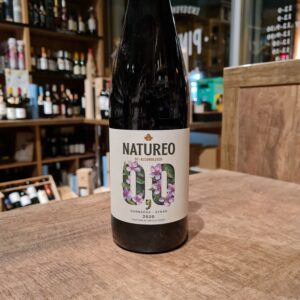 Red wine without alcohol (dealcoholized) made with Grenache and Syrah grapes.5% of the coupage maintains a brief aging in new French oak and subsequently undergoes the dealcoholisation process, maintaining all its aroma and flavour. This non-alcoholic red wine has an intense and delicious flavour. If you are a lover of red wines and want to avoid alcohol, this is a good option. If you do find the fruit coming up too strong, try chilling it to lower that strength. Serve it with pasta, roasts and game dishes
Red wine without alcohol (dealcoholized) made with Grenache and Syrah grapes.5% of the coupage maintains a brief aging in new French oak and subsequently undergoes the dealcoholisation process, maintaining all its aroma and flavour. This non-alcoholic red wine has an intense and delicious flavour. If you are a lover of red wines and want to avoid alcohol, this is a good option. If you do find the fruit coming up too strong, try chilling it to lower that strength. Serve it with pasta, roasts and game dishes -
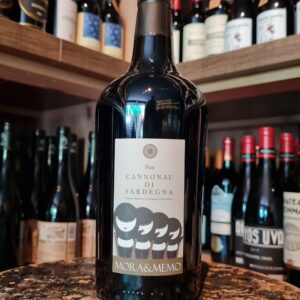 In a region dominated by cooperatives, Mora e Memo stand out for many reasons. This beautiful estate sits high in the hills in the South East of Sardinia just a few kilometres from the sea. Focused on the indigenous Sardinian varieties of Cannonau and Vermentino the combination of mature vineyards, sensitive farming and a delicate touch in their modern and technologically well equipped cellar results in elegant, vibrant mineral wines- very different from the rustic Sardinian norm. Pair it with Salami Antipasti, pasta dishes with tasty sauces, red meats, mature cheeses.
In a region dominated by cooperatives, Mora e Memo stand out for many reasons. This beautiful estate sits high in the hills in the South East of Sardinia just a few kilometres from the sea. Focused on the indigenous Sardinian varieties of Cannonau and Vermentino the combination of mature vineyards, sensitive farming and a delicate touch in their modern and technologically well equipped cellar results in elegant, vibrant mineral wines- very different from the rustic Sardinian norm. Pair it with Salami Antipasti, pasta dishes with tasty sauces, red meats, mature cheeses. -
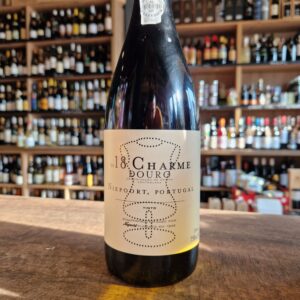 Another excellent wine from Niepoort. Charme is all about elegance and balance, achieved by taking special attention to the smallest details during the entire wine-making process. Made in traditional stone lagares with 100% grape stems, Charme’s elegance is achieved using grapes from very old vineyards in Vale de Mendiz, on the banks of the Pinhão river. Pair it with mushrooms and game dishes, such as partridge or pheasant
Another excellent wine from Niepoort. Charme is all about elegance and balance, achieved by taking special attention to the smallest details during the entire wine-making process. Made in traditional stone lagares with 100% grape stems, Charme’s elegance is achieved using grapes from very old vineyards in Vale de Mendiz, on the banks of the Pinhão river. Pair it with mushrooms and game dishes, such as partridge or pheasant -
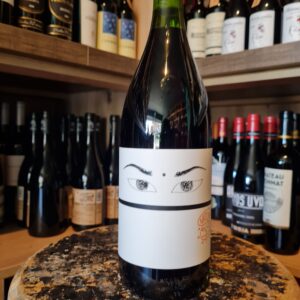 The Nat’Cool project is an innovative concept initiated by Niepoort, in which various producers came together to create light and easy-to-drink wines. This is the original Nat’Cool wine, from the Bairrada region where they are showcasing the elegant side of the Baga grape variety. Hands off wine making, Carbonic Maceration, soft, light expression of Baga. Baga is a touch grape which is very high in tannin and generally needs time to mature and express its delightful floral aromas and fruit character. However, here in the Bairrada with 80-100 year old vines and hands off wine making including carbonic maceration (which generally extracts less tannin), the astringent elements of the Baga grape are tamed and the resulting wine is pure juicy, fresh red with delicious wild berries, floral notes and light body. This wine is great fun, on opening there is a note of spritz but this vanishes quickly, I reckon it is just the wine's youthful spirit leaping from the bottle on its re-acquaintance with oxygen. What follows is very easy, juicy red which can be enjoyed chilled in the summer with a BBQ or at room temp in the autumn with some field mushrooms. The litre bottle and 12.5% abv is fantastic as between two, you have enough wine and not enough booze to make you suffer for it. A great addition to Niepoort portfolio, the wines go from strength to strength.
The Nat’Cool project is an innovative concept initiated by Niepoort, in which various producers came together to create light and easy-to-drink wines. This is the original Nat’Cool wine, from the Bairrada region where they are showcasing the elegant side of the Baga grape variety. Hands off wine making, Carbonic Maceration, soft, light expression of Baga. Baga is a touch grape which is very high in tannin and generally needs time to mature and express its delightful floral aromas and fruit character. However, here in the Bairrada with 80-100 year old vines and hands off wine making including carbonic maceration (which generally extracts less tannin), the astringent elements of the Baga grape are tamed and the resulting wine is pure juicy, fresh red with delicious wild berries, floral notes and light body. This wine is great fun, on opening there is a note of spritz but this vanishes quickly, I reckon it is just the wine's youthful spirit leaping from the bottle on its re-acquaintance with oxygen. What follows is very easy, juicy red which can be enjoyed chilled in the summer with a BBQ or at room temp in the autumn with some field mushrooms. The litre bottle and 12.5% abv is fantastic as between two, you have enough wine and not enough booze to make you suffer for it. A great addition to Niepoort portfolio, the wines go from strength to strength. -
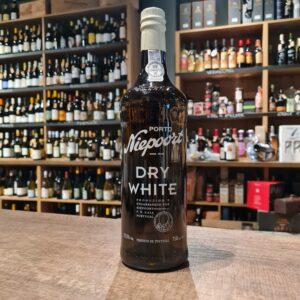 Niepoort is a Portuguese winery that was founded in 1842. It is currently run by Dirk Niepoort, fifth generation of the family it is named after. They use traditional Portuguese techniques such as grape treading, fermentation in cement tanks or aging in pipes, 550-litre port-aging barrels, whilst also using new technologies that ensure the grapes are handled with care. The winery has vines in different locations, some of which are over 100 years old, and an aging cellar in the town of Vila Nova de Gaia. The Niepoort Dry White vines have an average age of 30 years old and are planted in shale soils. The planting density of the plots ranges from 4,000 to 6,000 plants per hectare and the harvest is carried out manually to take the best care of the grapes. Serve as an aperitif, but it also goes down a treat as a dessert wine or simply on its own at the end of a meal
Niepoort is a Portuguese winery that was founded in 1842. It is currently run by Dirk Niepoort, fifth generation of the family it is named after. They use traditional Portuguese techniques such as grape treading, fermentation in cement tanks or aging in pipes, 550-litre port-aging barrels, whilst also using new technologies that ensure the grapes are handled with care. The winery has vines in different locations, some of which are over 100 years old, and an aging cellar in the town of Vila Nova de Gaia. The Niepoort Dry White vines have an average age of 30 years old and are planted in shale soils. The planting density of the plots ranges from 4,000 to 6,000 plants per hectare and the harvest is carried out manually to take the best care of the grapes. Serve as an aperitif, but it also goes down a treat as a dessert wine or simply on its own at the end of a meal -
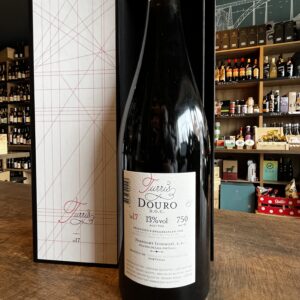
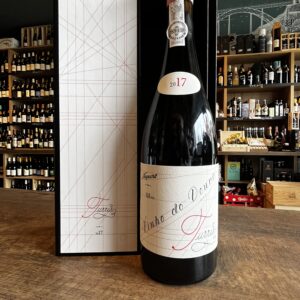 Turris is Niepoort's flagship red wine from the Cima Corgo region, more specifically from a very old South-facing vineyard whose vines are more than 130 years old , it is one of the oldest vineyards we know of in the region. This truly ancient, uncultivated vineyard lies hidden in the heart of the Douro Valley and is a true gift from our ancestors and refelcts every detail of nature and its area. These grapes from the Torre were always intended for one of Niepoort top wine Batuta and were a dream come true from Dirk Niepoort. The Turris was bottled quite early to preserve its freshness, minerality, youthful nature and the purity of its aromas and we expect it to show great aging potential. In addition to being a unique wine, each bottle is also unique because the labels were individually designed by the artist João Noutel.
Turris is Niepoort's flagship red wine from the Cima Corgo region, more specifically from a very old South-facing vineyard whose vines are more than 130 years old , it is one of the oldest vineyards we know of in the region. This truly ancient, uncultivated vineyard lies hidden in the heart of the Douro Valley and is a true gift from our ancestors and refelcts every detail of nature and its area. These grapes from the Torre were always intended for one of Niepoort top wine Batuta and were a dream come true from Dirk Niepoort. The Turris was bottled quite early to preserve its freshness, minerality, youthful nature and the purity of its aromas and we expect it to show great aging potential. In addition to being a unique wine, each bottle is also unique because the labels were individually designed by the artist João Noutel. -
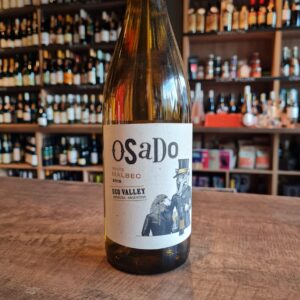 Being Osado or daring, is not being fearless, or not having second thoughts. Being Osado means living without prejudice, being free of any obligations and building your own way of life. Malbec brings a strong posture to this white wine and its aftertaste is long, fresh and clean. The grapes are harvested by hand in the cool of the morning, pressed under very low pressure so that no color has come off the grapes. The wine has been cold-consumed for 15 days and then matured in steel tanks on top of the precipitate for five months. This delicious wine is a very versatile food wine accompanied by grilled fish or asparagus, for example, and is also suitable as an aperitif as such. Grapes: Malbec 100%.
Being Osado or daring, is not being fearless, or not having second thoughts. Being Osado means living without prejudice, being free of any obligations and building your own way of life. Malbec brings a strong posture to this white wine and its aftertaste is long, fresh and clean. The grapes are harvested by hand in the cool of the morning, pressed under very low pressure so that no color has come off the grapes. The wine has been cold-consumed for 15 days and then matured in steel tanks on top of the precipitate for five months. This delicious wine is a very versatile food wine accompanied by grilled fish or asparagus, for example, and is also suitable as an aperitif as such. Grapes: Malbec 100%. -
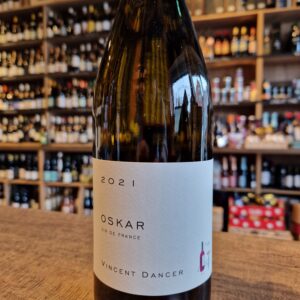
This is a unique wine from a once off production from Vincent Dancer. Oskar is the result of Vincent Dancer frustration with the low yeald of his top four Vineyards due frost that happen right after the fruit started to grow resulting in huge losses. Oskar is the name of Théo Dancer’s Australian Shepard.
So, this incredibly rare, one-off bottling comprises of a roughly equal amount of Chassagne-Montrachet 1er Cru La Romanée, Chassagne-Montrachet 1er Cru Tête du Clos, Meursault 1er Cru Perrières and Grand Cru Chevalier-Montrachet. Naturally, by blending across villages, Dancer has had to declassify this wine and chose Vin de France instead of the risker option of Bourgogne Blanc! Of course, this will have little bearing on a wine that is set to become a unicorn.
This true rarity from the Dancer estate is a pure sensory pleasure of great rarity, as only two barrels were produced. Pinto Wines has the enormous honour to stock Vincent Dancer in general nevermind this unique wine.
If you'd ask me I wouldn't drink this wine with food or any other beverage. Simply on it's own and and my best friend and wife. But if you really have to pair it then I would suggest stinky cheeses, seafood and why not the coq au vin
-
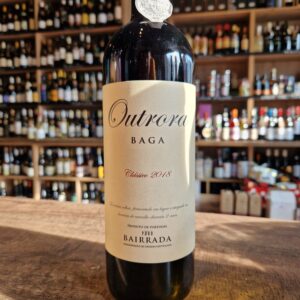 This Bairrada Classic wine is a tribute to the centenary vineyards, matriarchs of the region and witnesses of past times. The grapes are selected from 80 to 120 year old vines from our vineyard in the Cadoiços Valley. Winemaking in “lagar” with foot treading, besides being an old technique, we believe it remains the best way to obtain great wines of this variety. The two-year oak stage and subsequent bottle rest give the elegance and balance needed for a wine to be tasted for many years. An Impressive Bairrada!An Impressive Wine! Goes well with buttered Goat and Sheep Cheeses, traditional sausages (raw, boiled, or roasted), red meats
This Bairrada Classic wine is a tribute to the centenary vineyards, matriarchs of the region and witnesses of past times. The grapes are selected from 80 to 120 year old vines from our vineyard in the Cadoiços Valley. Winemaking in “lagar” with foot treading, besides being an old technique, we believe it remains the best way to obtain great wines of this variety. The two-year oak stage and subsequent bottle rest give the elegance and balance needed for a wine to be tasted for many years. An Impressive Bairrada!An Impressive Wine! Goes well with buttered Goat and Sheep Cheeses, traditional sausages (raw, boiled, or roasted), red meats -
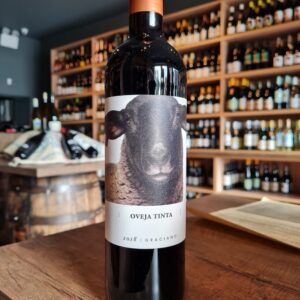 Graciano is one of Spain’s best kept wine secrets - a red grape with thick skins that is a tricky one to grow, which means there’s precious little of it about, even in the vineyards of the Rioja, where it is one of the traditional ingredients in the wine of the same name. This Biio-Organic wine has ruby red color with violet rims. On the nose aromas of wild flowers and ripe fruit, strawberry and blackberries. On the palate it is fresh and fruity, with a good level of acidity and moderate tannins.
Graciano is one of Spain’s best kept wine secrets - a red grape with thick skins that is a tricky one to grow, which means there’s precious little of it about, even in the vineyards of the Rioja, where it is one of the traditional ingredients in the wine of the same name. This Biio-Organic wine has ruby red color with violet rims. On the nose aromas of wild flowers and ripe fruit, strawberry and blackberries. On the palate it is fresh and fruity, with a good level of acidity and moderate tannins. -
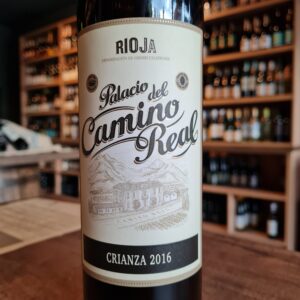 Palacio del Camino Real winery is located in the Najerilla Valley in Rioja. Isolated by the absence of railways and therefore the big wineries, the Najerilla Valley has maintained a tradition of small vineyards, consistently producing fruit of extraordinary freshness and quality. Palacio del Camino Real Crianza is a return to the essence of Rioja wines from the beginning of the 20th century in which Garnacha was the protagonist and a small percentage of white grapes could also be found. They are fresh, elegant, round and friendly wines. Palacio del Camino Real Crianza, is a red wine with an attractive ruby red color that impresses with its complex nose in which the nuances of its aging are perfectly integrated with the freshness and intensity of its chosen grapes. In the mouth it is a wine, it is a fresh, friendly, balanced wine with a long aftertaste.
Palacio del Camino Real winery is located in the Najerilla Valley in Rioja. Isolated by the absence of railways and therefore the big wineries, the Najerilla Valley has maintained a tradition of small vineyards, consistently producing fruit of extraordinary freshness and quality. Palacio del Camino Real Crianza is a return to the essence of Rioja wines from the beginning of the 20th century in which Garnacha was the protagonist and a small percentage of white grapes could also be found. They are fresh, elegant, round and friendly wines. Palacio del Camino Real Crianza, is a red wine with an attractive ruby red color that impresses with its complex nose in which the nuances of its aging are perfectly integrated with the freshness and intensity of its chosen grapes. In the mouth it is a wine, it is a fresh, friendly, balanced wine with a long aftertaste. -
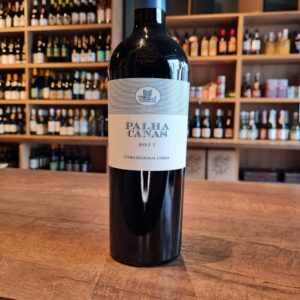 Aromatically very complex, it presents strong sensations of red fruits, jam and vanilla. Equally complex in the tasting, it evolutes to smooth velvety notes of red and ripe fruits, chocolate and oak ageing. Persistent and well-balanced aftertaste with tannins that evidence the structure of the wine and its longevity. Enjoy the Palha-Canas Tinto with hearty dishes from pork and beef, lamb and game. In addition, the wine goes perfectly with soft and hard cheese. You would have to stand on the terrace of the estate to understand why it is called Boavista (“fine view”). Your gaze would naturally wander over the vineyards which slope down into the valley in front of the house and then meet two hills on the opposite side where the lines of vines form an exciting geometrical pattern. It is a fine view indeed, this sight of the vineyards of Boavista. The Quinta de Boavista is situated right in the middle of the hills of the Estremadura wine-growing region, about fifty kilometres north of Lisbon. The close proximity of the nearby ocean provides for humidity and wind. The soil composition is a sandy clay. It is full of fossilized ocean deposits and right in front of the estate big petrified bones of a saurian were found which now adorn the terrace. The land has been owned for generations by the family of José Luis Oliveira da Silva. He is a banker by profession. For some years now he has focussed on wine-growing. He modernised the wine cellar, bought new barrels and recruited an able oenologist. He was among the first in Portugal who produced varietal wines from autochthonous grapes. The results are very exciting. The white Fernao Pires is a wine with attractive fruit aromas and with a distinct mineral note, the red Castelao and the red Tinta Roriz are wines that have concentration and a complex personality. This new generation of Portuguese wines gives you offhand inspiration.
Aromatically very complex, it presents strong sensations of red fruits, jam and vanilla. Equally complex in the tasting, it evolutes to smooth velvety notes of red and ripe fruits, chocolate and oak ageing. Persistent and well-balanced aftertaste with tannins that evidence the structure of the wine and its longevity. Enjoy the Palha-Canas Tinto with hearty dishes from pork and beef, lamb and game. In addition, the wine goes perfectly with soft and hard cheese. You would have to stand on the terrace of the estate to understand why it is called Boavista (“fine view”). Your gaze would naturally wander over the vineyards which slope down into the valley in front of the house and then meet two hills on the opposite side where the lines of vines form an exciting geometrical pattern. It is a fine view indeed, this sight of the vineyards of Boavista. The Quinta de Boavista is situated right in the middle of the hills of the Estremadura wine-growing region, about fifty kilometres north of Lisbon. The close proximity of the nearby ocean provides for humidity and wind. The soil composition is a sandy clay. It is full of fossilized ocean deposits and right in front of the estate big petrified bones of a saurian were found which now adorn the terrace. The land has been owned for generations by the family of José Luis Oliveira da Silva. He is a banker by profession. For some years now he has focussed on wine-growing. He modernised the wine cellar, bought new barrels and recruited an able oenologist. He was among the first in Portugal who produced varietal wines from autochthonous grapes. The results are very exciting. The white Fernao Pires is a wine with attractive fruit aromas and with a distinct mineral note, the red Castelao and the red Tinta Roriz are wines that have concentration and a complex personality. This new generation of Portuguese wines gives you offhand inspiration. -

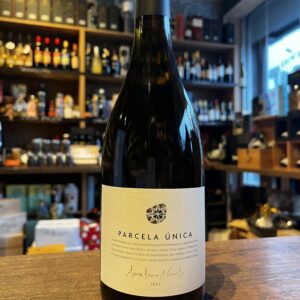 Born in Monção in Portugal’s Vinho Verde region, Anselmo Mendes fell in love with the Alvarinho grape at an early age and began making his first wines from the variety in 1988. Over the years he has consulted for many of Portugal’s top wineries and he also makes his own wines in Minho close to the border with Spain. Anselmo uses his decades of experience of working with Alvarinho to create a range of styles from crisp, light-bodied expressions to richer wines which are fermented and aged in oak barrels. A very versatile wine, it can be paired with stronger meat dishes or more complex fish, as well as shellfish and crustaceans. In the company of almond crusted cod on a bed of mashed potatoes or lamb chops with rosemary, Parcela Única wine in perfect harmony enhances fantastic flavors. Should be served between 11-13ºC. Technical sheet
Born in Monção in Portugal’s Vinho Verde region, Anselmo Mendes fell in love with the Alvarinho grape at an early age and began making his first wines from the variety in 1988. Over the years he has consulted for many of Portugal’s top wineries and he also makes his own wines in Minho close to the border with Spain. Anselmo uses his decades of experience of working with Alvarinho to create a range of styles from crisp, light-bodied expressions to richer wines which are fermented and aged in oak barrels. A very versatile wine, it can be paired with stronger meat dishes or more complex fish, as well as shellfish and crustaceans. In the company of almond crusted cod on a bed of mashed potatoes or lamb chops with rosemary, Parcela Única wine in perfect harmony enhances fantastic flavors. Should be served between 11-13ºC. Technical sheet -
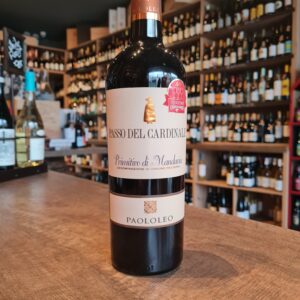 The Primitivo Paolo Leo Pass of the Cardinal is an ancient grape grape cultivated in Apulia, whose grapes present a very early maturation in comparison to other varieties, the name of which explains. One of the most interesting particularities of the Primitivo is the fact that, at a distance of only 20 days from the harvest, these grape vines are able to give a discreet second production of grapes. Traditionally, the fruits of this "second harvest" are used to increase the freshness of these ponderous wines, improving the deimosti acidity obtained from the first harvesting. The great body of the Primitivo di Manduria di Passo del Cardinale is able to enhance fine meats with a rigorous structure. Sliced beef and grilled steaks are the backdrop for a panoramic photograph. A touch of Puglia with orecchiette with chops sauce can be a gastronomic journey with which you can surprise your guests.
The Primitivo Paolo Leo Pass of the Cardinal is an ancient grape grape cultivated in Apulia, whose grapes present a very early maturation in comparison to other varieties, the name of which explains. One of the most interesting particularities of the Primitivo is the fact that, at a distance of only 20 days from the harvest, these grape vines are able to give a discreet second production of grapes. Traditionally, the fruits of this "second harvest" are used to increase the freshness of these ponderous wines, improving the deimosti acidity obtained from the first harvesting. The great body of the Primitivo di Manduria di Passo del Cardinale is able to enhance fine meats with a rigorous structure. Sliced beef and grilled steaks are the backdrop for a panoramic photograph. A touch of Puglia with orecchiette with chops sauce can be a gastronomic journey with which you can surprise your guests. -
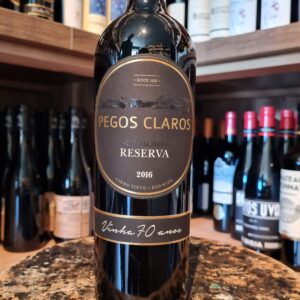 Producing quality wines since 1920, Pegos Claros Estate Farm was responsible in the 90s for the production of wines which became national and international references of the best wines produced as DOC Palmela. Harvesting done manually followed by fermentation with traditional foot treading in open “lagar”, oak ageing and exclusively from old vines. Produced from autochthonous red grapes of Castelão from Palmela Region, Pegos Claros Reserva is a red wine that reveals itself with defined maturity, with well-marked black fruits aromas in its aromatic bouquet, balsamic notes, and spices. It is a complex red wine with good acidity and a very elegant structure. Pairs well with grilled meat and roasted fish and meat.
Producing quality wines since 1920, Pegos Claros Estate Farm was responsible in the 90s for the production of wines which became national and international references of the best wines produced as DOC Palmela. Harvesting done manually followed by fermentation with traditional foot treading in open “lagar”, oak ageing and exclusively from old vines. Produced from autochthonous red grapes of Castelão from Palmela Region, Pegos Claros Reserva is a red wine that reveals itself with defined maturity, with well-marked black fruits aromas in its aromatic bouquet, balsamic notes, and spices. It is a complex red wine with good acidity and a very elegant structure. Pairs well with grilled meat and roasted fish and meat. -
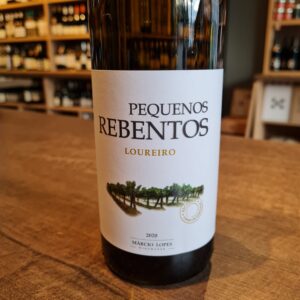 Márcio Lopes studied as an engineer, but cut his winemaking teeth working for two years with Vinho Verde master Anselmo Mendes in Melgaço. He then travelled to Australia where he made wine in Rutherglen and Tasmania, another cool climate region. He returned to Portugal in 2010 to start his own projects, including Pequenos Rebentos in Vinho Verde. He initially started working with Alvarinho and Trajadura (known as Albariño and Treixadura in Spain) from the sub-regions of Monção and Melgaço. These areas have a very particular microclimate, with slightly less Atlantic influence than the rest of the region - winters are cold with moderate rainfall and summers are hot and dry. During 2016 he also started to grow and vinify local varietals Loureiro. He now farms 5ha of vineyards, planted on granite, as well as buying some grapes from selected growers who also work in the same sustainable way and without herbicides. His winemaking is low intervention, he ferments using natural yeasts, and like many of our producers he believes that if the fruit is good enough he will make quality wines with balance that reflect his terroir. This seems to be working - his wines are distinctively fresh and vibrant, showing bright and clear typical variety aromas.
Márcio Lopes studied as an engineer, but cut his winemaking teeth working for two years with Vinho Verde master Anselmo Mendes in Melgaço. He then travelled to Australia where he made wine in Rutherglen and Tasmania, another cool climate region. He returned to Portugal in 2010 to start his own projects, including Pequenos Rebentos in Vinho Verde. He initially started working with Alvarinho and Trajadura (known as Albariño and Treixadura in Spain) from the sub-regions of Monção and Melgaço. These areas have a very particular microclimate, with slightly less Atlantic influence than the rest of the region - winters are cold with moderate rainfall and summers are hot and dry. During 2016 he also started to grow and vinify local varietals Loureiro. He now farms 5ha of vineyards, planted on granite, as well as buying some grapes from selected growers who also work in the same sustainable way and without herbicides. His winemaking is low intervention, he ferments using natural yeasts, and like many of our producers he believes that if the fruit is good enough he will make quality wines with balance that reflect his terroir. This seems to be working - his wines are distinctively fresh and vibrant, showing bright and clear typical variety aromas. -
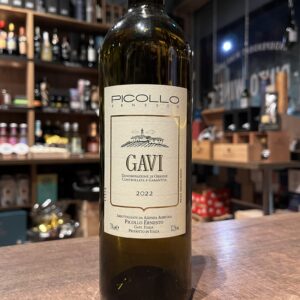 Picollo Gavi Ernesto is perched among the rolling hills that surround the town of Gavi. The climate here is much more mediterranean than in the north, benefiting from the constant maritime breezes, unique to the southern Piedmont. Picollo Ernesto’s vineyards sit near 260 meters above sea level in Rovereto di Gavi, one of the most prestigious area of the appellation. Our 16 hectares of vineyards are planted exclusively with Cortese, a hearty, high acid white varietal, perfectly suited for this area in northern Italy. Cortese thrives in difficult soil, dry climate, and full sun exposure, which Rovereto amply provides. Picollo’s vineyards are predominantly south-facing and the soils have a higher concentration of clay than marl, which allows for year-round water conservation, even in the peak of summer. Lorenzo Picollo founded the winery in 1945. The winemaking and day-to-day management was transferred to his son, Ernesto, and is now in the hands of his grandson, Gianlorenzo. Innovating along the way, Gianlorenzo continues to carry the family’s legacy forward with great success. Their lands are predominantly in the Rovereto zone, the historic Le Rive vineyards are over sixty years old instead their newest purchase of two hectares lies within the zone of Tassarolo. The grapes for all of Picollo’s wines are hand harvested. The winery itself has recently been modernized but the processes remain traditional, with sparing intervention in the winemaking and no artificial pesticides or herbicides used in the vineyards. With the intent of showcasing the Cortese in its purest form. All Gavi’s are fermented and aged exclusively in stainless steel. It is perfect with haute cuisine, ideal for fish dishes and aperitif
Picollo Gavi Ernesto is perched among the rolling hills that surround the town of Gavi. The climate here is much more mediterranean than in the north, benefiting from the constant maritime breezes, unique to the southern Piedmont. Picollo Ernesto’s vineyards sit near 260 meters above sea level in Rovereto di Gavi, one of the most prestigious area of the appellation. Our 16 hectares of vineyards are planted exclusively with Cortese, a hearty, high acid white varietal, perfectly suited for this area in northern Italy. Cortese thrives in difficult soil, dry climate, and full sun exposure, which Rovereto amply provides. Picollo’s vineyards are predominantly south-facing and the soils have a higher concentration of clay than marl, which allows for year-round water conservation, even in the peak of summer. Lorenzo Picollo founded the winery in 1945. The winemaking and day-to-day management was transferred to his son, Ernesto, and is now in the hands of his grandson, Gianlorenzo. Innovating along the way, Gianlorenzo continues to carry the family’s legacy forward with great success. Their lands are predominantly in the Rovereto zone, the historic Le Rive vineyards are over sixty years old instead their newest purchase of two hectares lies within the zone of Tassarolo. The grapes for all of Picollo’s wines are hand harvested. The winery itself has recently been modernized but the processes remain traditional, with sparing intervention in the winemaking and no artificial pesticides or herbicides used in the vineyards. With the intent of showcasing the Cortese in its purest form. All Gavi’s are fermented and aged exclusively in stainless steel. It is perfect with haute cuisine, ideal for fish dishes and aperitif -
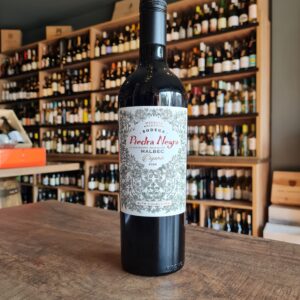 François Lurton vineyards are situated in the highlands (1,100 m) and semi-desert (poor alluvial gravels reminiscent of those of Pessac-Léognan), in the plains at the foot of the mountain range of the Andes: the Uco Valley. Thanks to his experience, acquired all over the world, he practices an environmentally friendly viticulture and produces extraordinary wines here that have a unique personality that combines freshness and concentration. Thanks to the climatic conditions of this high altitude desert and very draining and not very fertile alluvial gravel soils, the wines of the Uco Valley, and especially those of Los Chacayes, are quite unique and François Lurton vision was a success. This Malbec has a an outstanding quality/price ratio and it is definitely a contender not only for those summer barbecues but also for those cold winter nights. Pair it with Carpaccio, Paella, Iberian ham, red pepper stuffed with cheese and Hummus.
François Lurton vineyards are situated in the highlands (1,100 m) and semi-desert (poor alluvial gravels reminiscent of those of Pessac-Léognan), in the plains at the foot of the mountain range of the Andes: the Uco Valley. Thanks to his experience, acquired all over the world, he practices an environmentally friendly viticulture and produces extraordinary wines here that have a unique personality that combines freshness and concentration. Thanks to the climatic conditions of this high altitude desert and very draining and not very fertile alluvial gravel soils, the wines of the Uco Valley, and especially those of Los Chacayes, are quite unique and François Lurton vision was a success. This Malbec has a an outstanding quality/price ratio and it is definitely a contender not only for those summer barbecues but also for those cold winter nights. Pair it with Carpaccio, Paella, Iberian ham, red pepper stuffed with cheese and Hummus. -
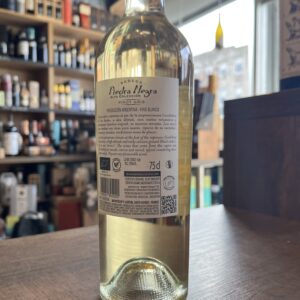
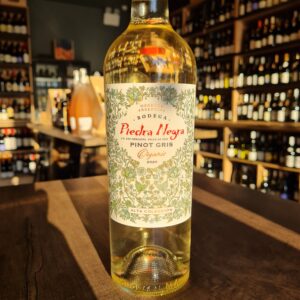 The Alta Colleción Pinot Gris from Bodega Piedra Negra can be considered an excellent ambassador of the unique Lurton wine style. A clear fruit, seductive grace and an unmistakable personality characterise this pure Pinot Gris.This wine fills the glass with a bright straw yellow with greenish reflections. The fragrant bouquet unfolds fresh fruity, aromatic notes of white peach and pear. The fresh, juicy taste brings lots of fruit and a lively acidity. Despite everything, this Argentine white wine is soft, full-bodied and wonderfully balanced, making it a racy and charming seducer. In the finish, the beautiful aroma lasts for a long time. This dry white wine from Argentina goes excellently with pasta with fish and seafood, monkfish with provencal herbs and spices or roasted pork.
The Alta Colleción Pinot Gris from Bodega Piedra Negra can be considered an excellent ambassador of the unique Lurton wine style. A clear fruit, seductive grace and an unmistakable personality characterise this pure Pinot Gris.This wine fills the glass with a bright straw yellow with greenish reflections. The fragrant bouquet unfolds fresh fruity, aromatic notes of white peach and pear. The fresh, juicy taste brings lots of fruit and a lively acidity. Despite everything, this Argentine white wine is soft, full-bodied and wonderfully balanced, making it a racy and charming seducer. In the finish, the beautiful aroma lasts for a long time. This dry white wine from Argentina goes excellently with pasta with fish and seafood, monkfish with provencal herbs and spices or roasted pork. -
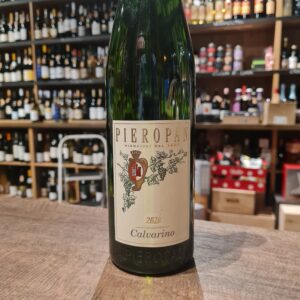 The history of this brand dates back to 1880, when this business was established in the Soave village in the reputed zone of Palazzo Pullici in Italy. Leonildo Pieropan, a physician from Soave, was well-aware of the potential of the soils in this region, because of his previous work experience in the family vineyards. He, along with his sons, Fausto and Gustavo, started working in the cellars in the 1950s and 60s to churn out impeccable quality, Italian wines that spoke a lot about the quality of their terroirs. Today, this business is run by the fifth generation of the Pieropan family, with the same dedication and winemaking philosophy. The Pieropan family believes in traditional winemaking principles. These are reflected in the way they maintain their vineyards. The local territory of these vineyards is given utmost importance and minimalistic intervention technique is followed in addition to organic viticultural practices. The three vineyards from where grapes are sourced for Pieropan wines are Calvarino, La Rocca and Garzon. Calvarino vineyard is the oldest of the three as it has been with the family since 1901. It is located right in the heart of the Soave area and is blessed with amazingly rich and fertile volcanic soils. It makes an excellent aperitif and partners a wide range of dishes, especially vegetable quiches, delicately-flavoured fish, shellfish and cheese soufflés
The history of this brand dates back to 1880, when this business was established in the Soave village in the reputed zone of Palazzo Pullici in Italy. Leonildo Pieropan, a physician from Soave, was well-aware of the potential of the soils in this region, because of his previous work experience in the family vineyards. He, along with his sons, Fausto and Gustavo, started working in the cellars in the 1950s and 60s to churn out impeccable quality, Italian wines that spoke a lot about the quality of their terroirs. Today, this business is run by the fifth generation of the Pieropan family, with the same dedication and winemaking philosophy. The Pieropan family believes in traditional winemaking principles. These are reflected in the way they maintain their vineyards. The local territory of these vineyards is given utmost importance and minimalistic intervention technique is followed in addition to organic viticultural practices. The three vineyards from where grapes are sourced for Pieropan wines are Calvarino, La Rocca and Garzon. Calvarino vineyard is the oldest of the three as it has been with the family since 1901. It is located right in the heart of the Soave area and is blessed with amazingly rich and fertile volcanic soils. It makes an excellent aperitif and partners a wide range of dishes, especially vegetable quiches, delicately-flavoured fish, shellfish and cheese soufflés -
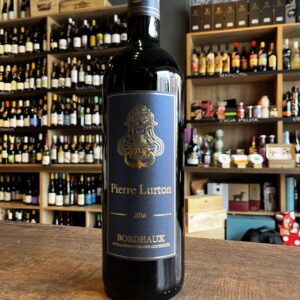 Bordeaux Pierre Lurton is a wine produced by Pierre Lurton in his namesake wine cellars. He draws directly from his knowledge acquired in the most prestigious properties of Bordeaux. Thus, this wine is rigorously selected by Pierre Lurton.The colour of the label also reflects the classic colour of the mansions of Gironde´s capital.
Bordeaux Pierre Lurton is a wine produced by Pierre Lurton in his namesake wine cellars. He draws directly from his knowledge acquired in the most prestigious properties of Bordeaux. Thus, this wine is rigorously selected by Pierre Lurton.The colour of the label also reflects the classic colour of the mansions of Gironde´s capital. -
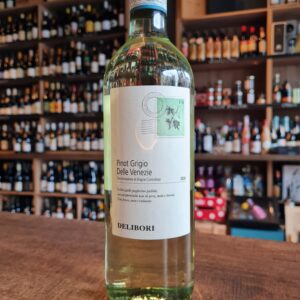 The Delibori Pinot Grigio delle Venezie impresses with its elegantly dry taste. It was bottled with exceptionally low residual sugar. This is a true quality wine, which clearly stands out from simpler qualities and so this Italian naturally enchants with the finest balance despite all dryness. Excellent taste does not necessarily require a lot of sugar. Light-footed and multi-layered, this light white wine presents itself on the palate. The final of this youthful white wine from the wine-growing region of Veneto, more precisely from Delle Venezie DOC, finally convinces with good reverberation. Best enjoyed moderately chilled at 11 - 13°C. It is perfect as an accompaniment to pumpkin casserole, vegetable stew with pesto or leek tortilla.
The Delibori Pinot Grigio delle Venezie impresses with its elegantly dry taste. It was bottled with exceptionally low residual sugar. This is a true quality wine, which clearly stands out from simpler qualities and so this Italian naturally enchants with the finest balance despite all dryness. Excellent taste does not necessarily require a lot of sugar. Light-footed and multi-layered, this light white wine presents itself on the palate. The final of this youthful white wine from the wine-growing region of Veneto, more precisely from Delle Venezie DOC, finally convinces with good reverberation. Best enjoyed moderately chilled at 11 - 13°C. It is perfect as an accompaniment to pumpkin casserole, vegetable stew with pesto or leek tortilla. -
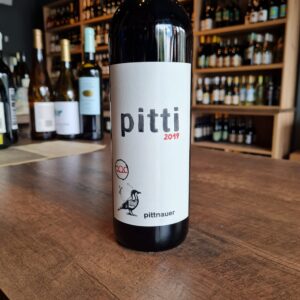 High on the hills of Austria there is more than just a lonely goat herd - there is also a fantastic winery, considered one of the country's best. Pittnauer has a long winemaking tradition in the region, and in 2006 moved to more biodynamic practices. The results are delicious, environmentally friendly wines with years of experience behind them. Now prepare yourself for some varieties you've probably never heard of - Pittnauer's Pitti Red Blend is made from blaufränkisch and Zweigelt grapes with a small quantity of Merlot added to the mixture. These varieties shine brightest in the Austrian climate, where they come together to make a stunningly delicious, full bodied wine reminiscent of spicy Shiraz. The ‘Pitti’ is a blend coming from vines that average 12-15 years in age and are planted on sandy clay mixed with limestone. Dark ruby in colour, the wine has tight tannins with black berries, cherries, cranberries and fresh acidic structure. Whispers of tobacco and liquorice. Ticks all the boxes of quality, drinkability and affordability and yumability.
High on the hills of Austria there is more than just a lonely goat herd - there is also a fantastic winery, considered one of the country's best. Pittnauer has a long winemaking tradition in the region, and in 2006 moved to more biodynamic practices. The results are delicious, environmentally friendly wines with years of experience behind them. Now prepare yourself for some varieties you've probably never heard of - Pittnauer's Pitti Red Blend is made from blaufränkisch and Zweigelt grapes with a small quantity of Merlot added to the mixture. These varieties shine brightest in the Austrian climate, where they come together to make a stunningly delicious, full bodied wine reminiscent of spicy Shiraz. The ‘Pitti’ is a blend coming from vines that average 12-15 years in age and are planted on sandy clay mixed with limestone. Dark ruby in colour, the wine has tight tannins with black berries, cherries, cranberries and fresh acidic structure. Whispers of tobacco and liquorice. Ticks all the boxes of quality, drinkability and affordability and yumability. -
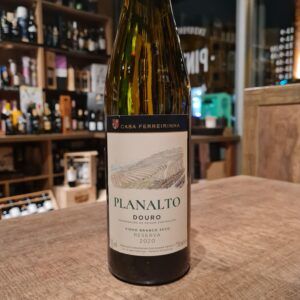 Planalto is one of the biggest references of white wine in the Douro Demarcated Region, fruit of the in-depth studies carried out over the years, the careful choice of the grape varieties that compose it and the use of the best winemaking technology in its production. This white blend comes from high-altitude vineyards above the river Douro. The soil in the Douro Valley is schistous; a slate-like metamorphic rock that fractures vertically - allowing vine roots to dig deep to access water and nutrients to sustain them through the hot Douro summers. The poor quality of the soil forces the grapes to produce low yields of grapes with a great concentration of flavour. The grapes were harvested by hand and were selected for their balance between flavour intensity and freshness. Ideal to accompany fish, seafood and white meat dishes.
Planalto is one of the biggest references of white wine in the Douro Demarcated Region, fruit of the in-depth studies carried out over the years, the careful choice of the grape varieties that compose it and the use of the best winemaking technology in its production. This white blend comes from high-altitude vineyards above the river Douro. The soil in the Douro Valley is schistous; a slate-like metamorphic rock that fractures vertically - allowing vine roots to dig deep to access water and nutrients to sustain them through the hot Douro summers. The poor quality of the soil forces the grapes to produce low yields of grapes with a great concentration of flavour. The grapes were harvested by hand and were selected for their balance between flavour intensity and freshness. Ideal to accompany fish, seafood and white meat dishes.


